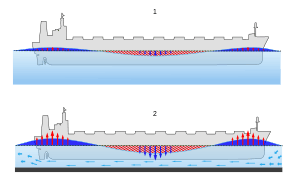Squat effect
The squat effect is the hydrodynamic phenomenon by which a vessel moving quickly through shallow water creates an area of lowered pressure that causes the ship to be closer to the seabed than would otherwise be expected. This phenomenon is caused when water that should normally flow under the hull encounters resistance due to the close proximity of the hull to the seabed. Leonardo's law causes the water to move faster in water level (where section is smaller); according to Bernoulli's principle, the increasing velocity causes low pressure, such that the ship is pulled down. Squat effect from a combination of vertical sinkage and a change of trim may cause the vessel to dip towards the stern or towards the bow.[1]

Squat effect is approximately proportional to the square of the speed of the ship. Thus, by reducing speed by half, the squat effect is reduced by a factor of four.[2] Squat effect is usually felt more when the depth/draft ratio is less than four[2] or when sailing close to a bank. It can lead to unexpected groundings and handling difficulties.
It was a cause of the 7 August 1992 grounding of the Queen Elizabeth 2 (QE2) off Cuttyhunk Island, near Martha's Vineyard. The liner's speed at the time was 24 knots (12 m/s) and the draft was 32 feet (9.8 m). The rock upon which the vessel grounded was an uncharted shoal later determined to be 34.5 feet (10.5 m), which should have given her room to spare, were it not for the "squat effect."[3] U.S. National Transportation Safety Board investigators found that the QE2's officers significantly underestimated the amount the increase in speed would increase the ship's squat. The officers allowed for 2 feet (0.61 m) of squat in their calculations, but the NTSB concluded that squat at that speed and depth would have been between 4.5 and 8 feet (1.4 and 2.4 m).[4]
Squat is also mentioned as a factor in the collision of the bulk carriers Tecam Sea and Federal Fuji in the port of Sorel, Quebec, in April 2000.[1]
The third largest cruise ship in the world, MS Oasis of the Seas, used this effect to obtain an extra margin of clearance between the vessel and the Great Belt bridge, Denmark, 1 November 2009, on a voyage from the shipyard in Turku, Finland to Florida, USA.[5] The new cruise liner passed under the bridge at 20 knots (37 km/h) in the shallow channel, giving the ship extra clearance due to a 30 cm squat.
References
- "Marine Investigation Report M00L0039". Transportation Safety Board of Canada. 27 April 2000. Retrieved 6 March 2019.
- "Navigation and Vessel Inspection Circular" (PDF). Retrieved February 11, 2008.
- Marine Surveyors Find Uncharted Rock That May Have Damaged Hull of the QE2, New York Times, 15 August 1992
- Marine Accident Report—Grounding of the United Kingdom Passenger Vessel RMS QUEEN ELIZABETH 2 Near Cuttyhunk Island, Vineyard Sound, Massachusetts, August 7, 1992 (NTSB/MAR-93/01), pp. 26-30. National Transportation Safety Board: 25 May 1993.
- Wright, William, "Clearing a Landmark", Captain's Log, Day Three, Royal Caribbean at Oasis of the Seas Archived 2010-06-20 at the Wayback Machine; „Oasis of the Seas“ hat Kurs auf Fehmarn Archived 2009-11-03 at the Wayback Machine, KN-online (31 October 2009) (German)
Further reading
- Society of Naval Architects and Marine Engineers (SNAME), "Principles of Naval Architecture", 1989, Vol. II "Resistance and Propulsion"